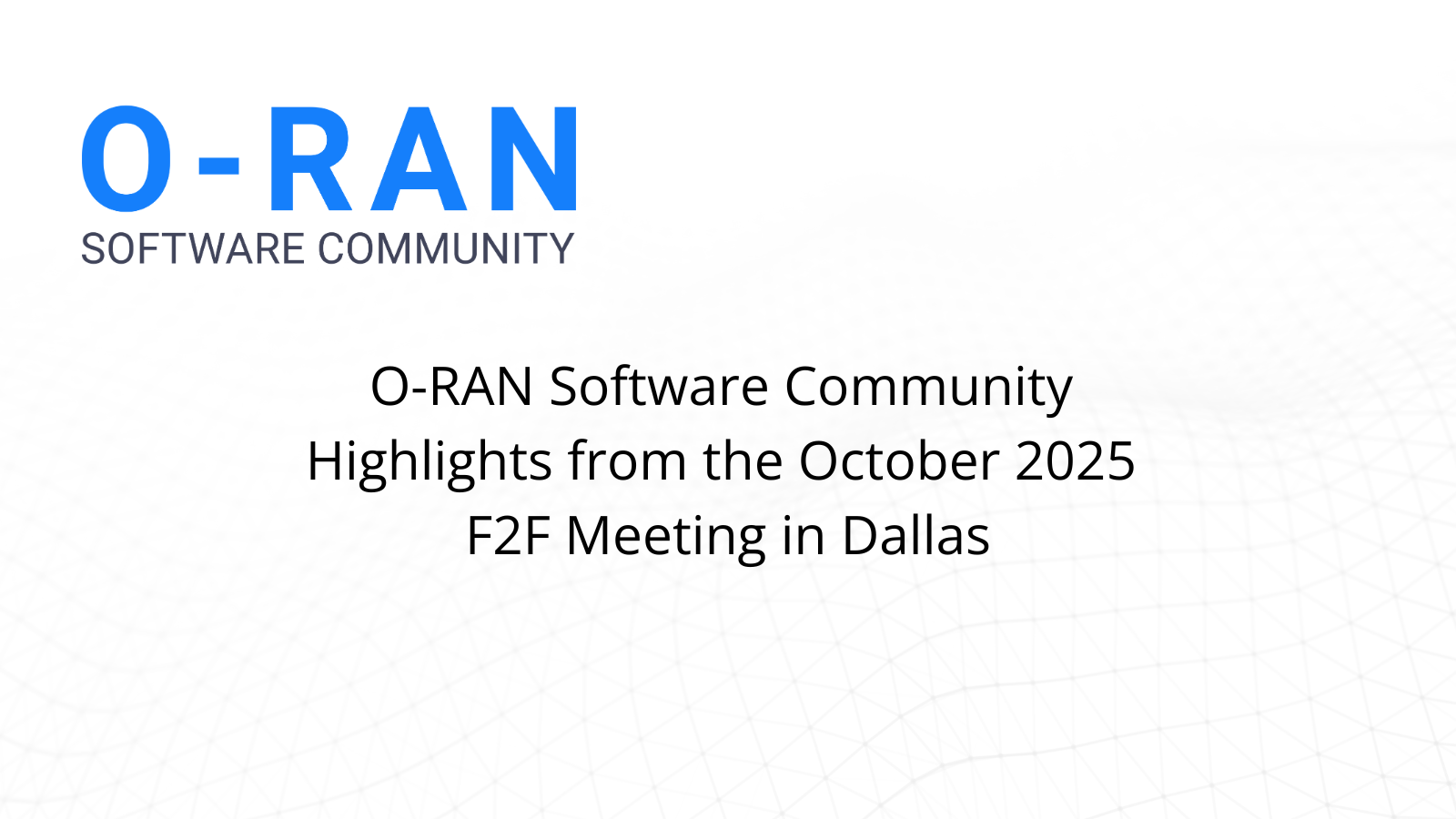


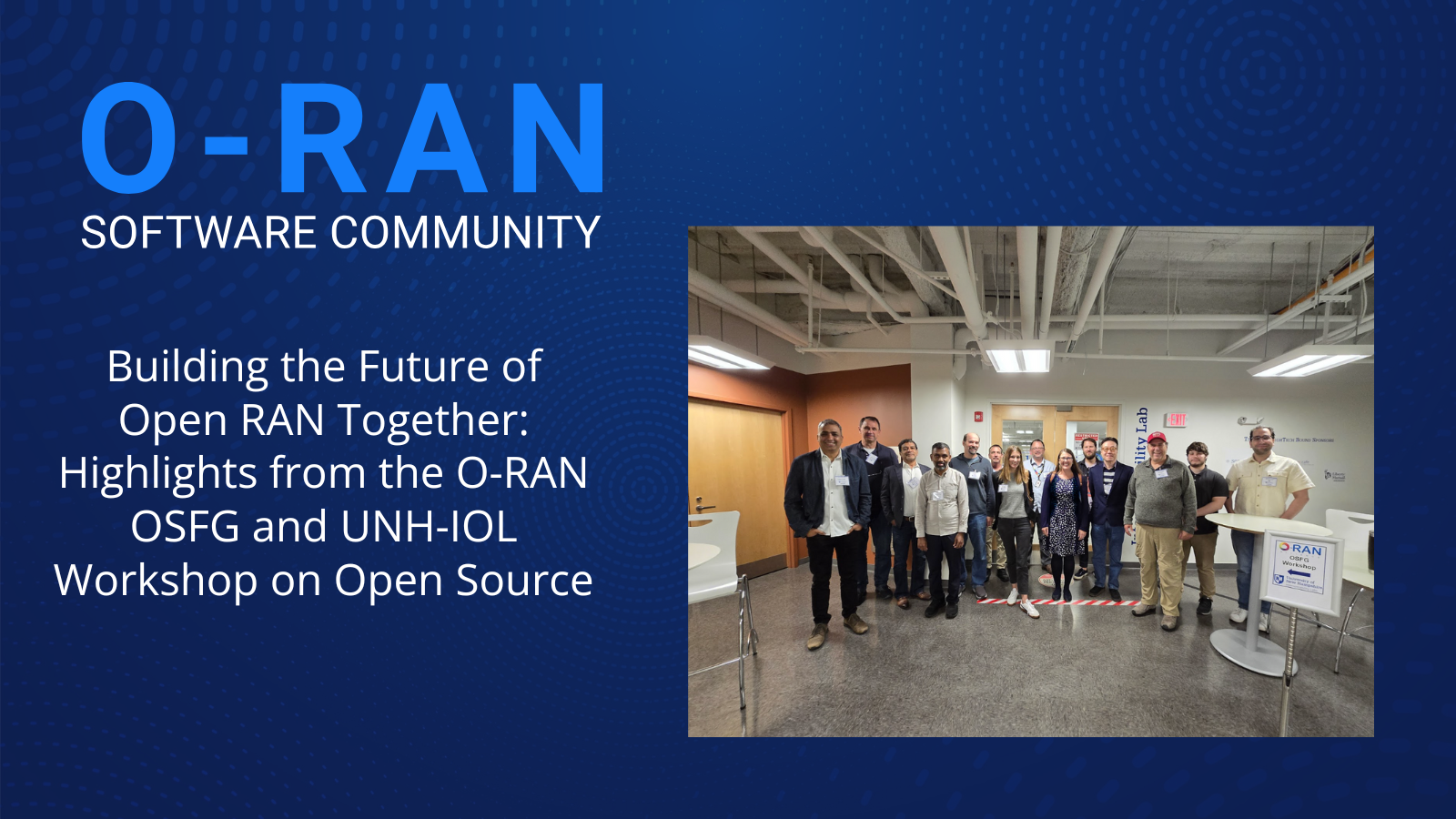
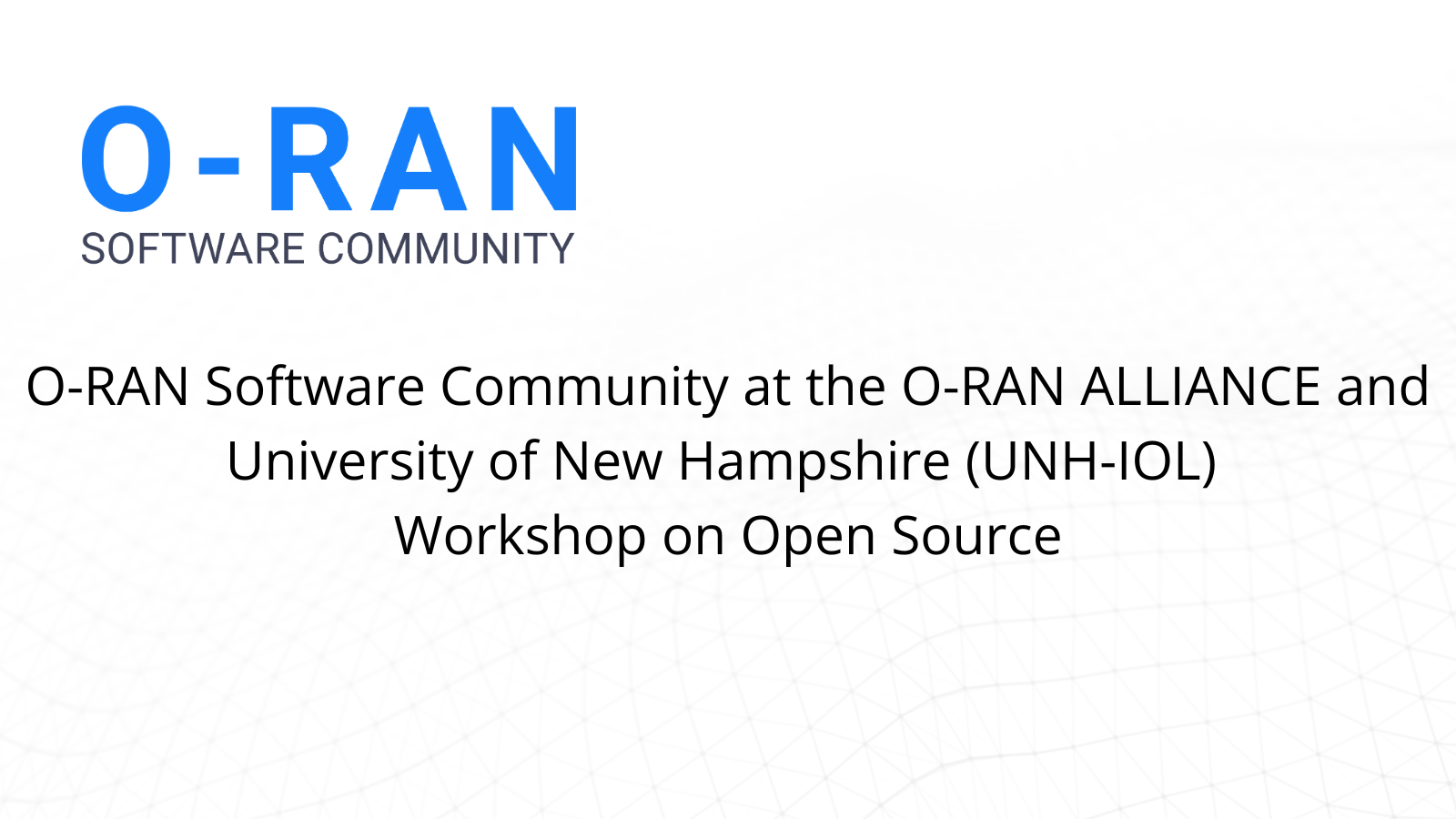
The O-RAN Software Community (SC) is pleased to share that we will be in attendance at the O-RAN ALLIANCE Open Source Focus Group (OSFG) / University of New Hampshire Interoperability Laboratory (UNH-IOL) Workshop on Open Source, taking place October 1–2, 2025 at the University of New Hampshire Interoperability Labs in Durham, NH, USA.
This workshop, co-sponsored by the O-RAN ALLIANCE OSFG and UNH-IOL, will bring together open source projects and community participants from across the end-to-end mobile network ecosystem. The discussions will span Radio Access Network (RAN), Core, Infrastructure, and Cloud, with a focus on promoting alignment, integration, and collaboration between projects.
Open source is central to the vision of O-RAN, helping to ensure openness, interoperability, and innovation across Radio Access Networks. The workshop will provide an opportunity to:
By participating, the O-RAN SC looks forward to contributing to these conversations and reinforcing the importance of collaboration between open source and standards efforts.
The O-RAN SC plays a critical role in delivering open source implementations that bring the O-RAN ALLIANCE’s architecture and specifications to life. Our community is advancing projects that are directly relevant to the workshop’s focus areas, including:
We look forward to sharing our progress and learning from other participants, with the goal of strengthening the entire open RAN ecosystem.
The two-day agenda includes:
Each track will provide a readout and recommendations back to the broader group, helping to shape next steps for integration and collaboration.
The workshop is open to all participants from the industry. O-RAN ALLIANCE membership is not required. Both in-person and virtual attendance options are available, and lunch will be provided for onsite participants.
📅 Date: October 1–2, 2025
📍 Location: UNH Interoperability Labs, 21 Madbury Rd., Durham, NH, USA
👉 Register here to secure your spot.
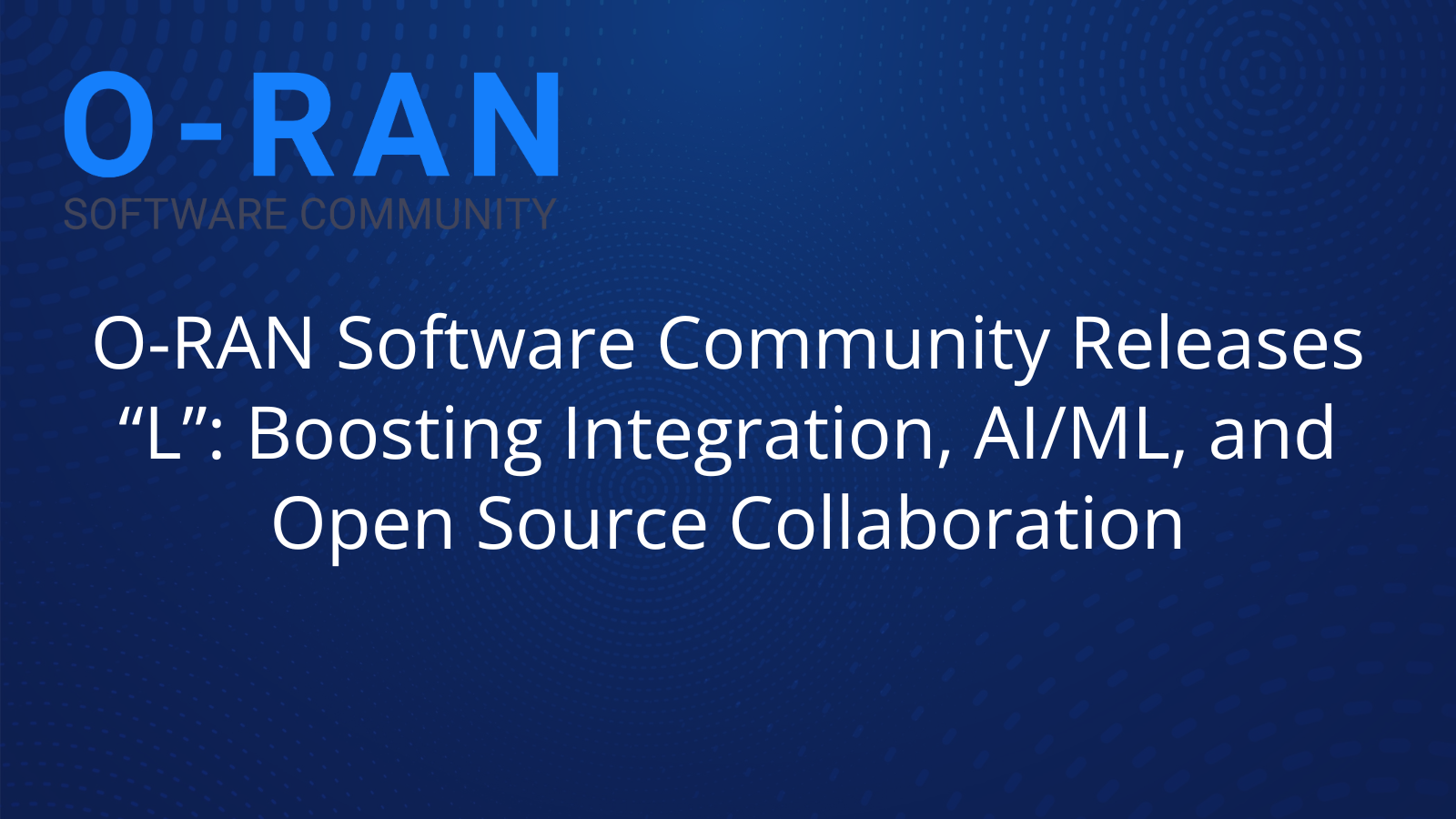
The O-RAN Software Community (O-RAN SC) is excited to announce the L Release, the latest update in our collaborative mission to deliver open, intelligent, and interoperable RAN software. Reflecting current and evolving alignment with O-RAN ALLIANCE specifications and developed through contributions from across the global open source ecosystem, this release introduces improvements in integration, automation, and AI/ML enablement across the stack.
Whether you’re a developer, network operator, academic researcher, or open source advocate, the L Release provides powerful building blocks to support testing, integration, and innovation across the Open RAN (O-RAN) ecosystem.
The L Release is a major milestone for the open RAN and open source communities. It highlights how cross-industry collaboration and transparent development practices can drive the evolution of modular, intelligent, and interoperable RAN technologies.
Key benefits of the L Release:
The L Release delivers updates across four key areas:
Whether you’re building next-generation mobile networks, developing new xApps or rApps, or researching AI in telecom, the O-RAN Software Community welcomes your involvement.
Stay tuned for what’s next in the M Release!

The Open Source Focus Group (OSFG) of the O-RAN ALLIANCE convened an ad-hoc meeting on May 23, 2025, hosted by Ericsson in Kista, Sweden. The goal: to identify key open source initiatives relevant to O-RAN, evaluate testing infrastructure needs, and begin planning a collaborative workshop for later this year. The event brought together participants from the O-RAN Software Community (SC), O-RAN Working and Focus Groups, and multiple member companies across the ecosystem.
The meeting began with a restatement of OSFG’s mission, led by Co-Chairs Irfan Ghauri (EURECOM/OpenAirInterface), James Li (China Mobile), and David Kinsey (AT&T), supported by Martin Skorupski (Highstreet Technologies). The group reaffirmed its commitment to openness, transparency, and non-confidential discussion per O-RAN ALLIANCE guidelines.
A series of technical presentations offered insight into open source workstreams intersecting with O-RAN priorities:
OSFG is actively working to align with other Linux Foundation and CNCF projects. Efforts include outreach and coordination with:
The group discussed possibly inviting representatives from these projects to the next OSFG workshop.
A brief update on the EU Cyber Resilience Act (CRA) was delivered by Jimmy Ahlberg (Ericsson). Key takeaways:
Sridhar Rao (Linux Foundation) led a discussion on O-RAN SC’s CVE process—covering scanning, dashboard reporting, and plans to bring on interns to address critical issues by the end of 2025. The group is also exploring whether CVE data should be published on [cve.org] and/or in blog posts.
A proposal was made to request funding for security interns via TOC (Technical Oversight Committee). The broader question of each project’s security stance (“want to fix,” “not interested,” etc.) remains open and will be addressed at the project level in O-RAN SC meetings.
The OSFG officially acknowledged the signed Memorandum of Understanding (MoU) between O-RAN ALLIANCE and the Linux Foundation Networking (LFN), which establishes a basis for inviting LFN participants into OSFG activities. The meeting explored ways to streamline the invitation process for recurring contributors.
The group concluded with action items to support an upcoming workshop tentatively targeted for September 2025. Nephio is already planning a face-to-face event, and a joint session with OSFG/O-RAN SC was proposed. The group aims to:
The OSFG ad-hoc meeting in Kista underscored the importance of open collaboration, strategic alignment, and technical integration between the O-RAN ecosystem and open source communities. With a renewed focus on testing infrastructure, security posture, and a shared workshop agenda, the group is poised to enhance the impact of open RAN across global deployments.For additional details or to get involved, please visit the O-RAN SC website.
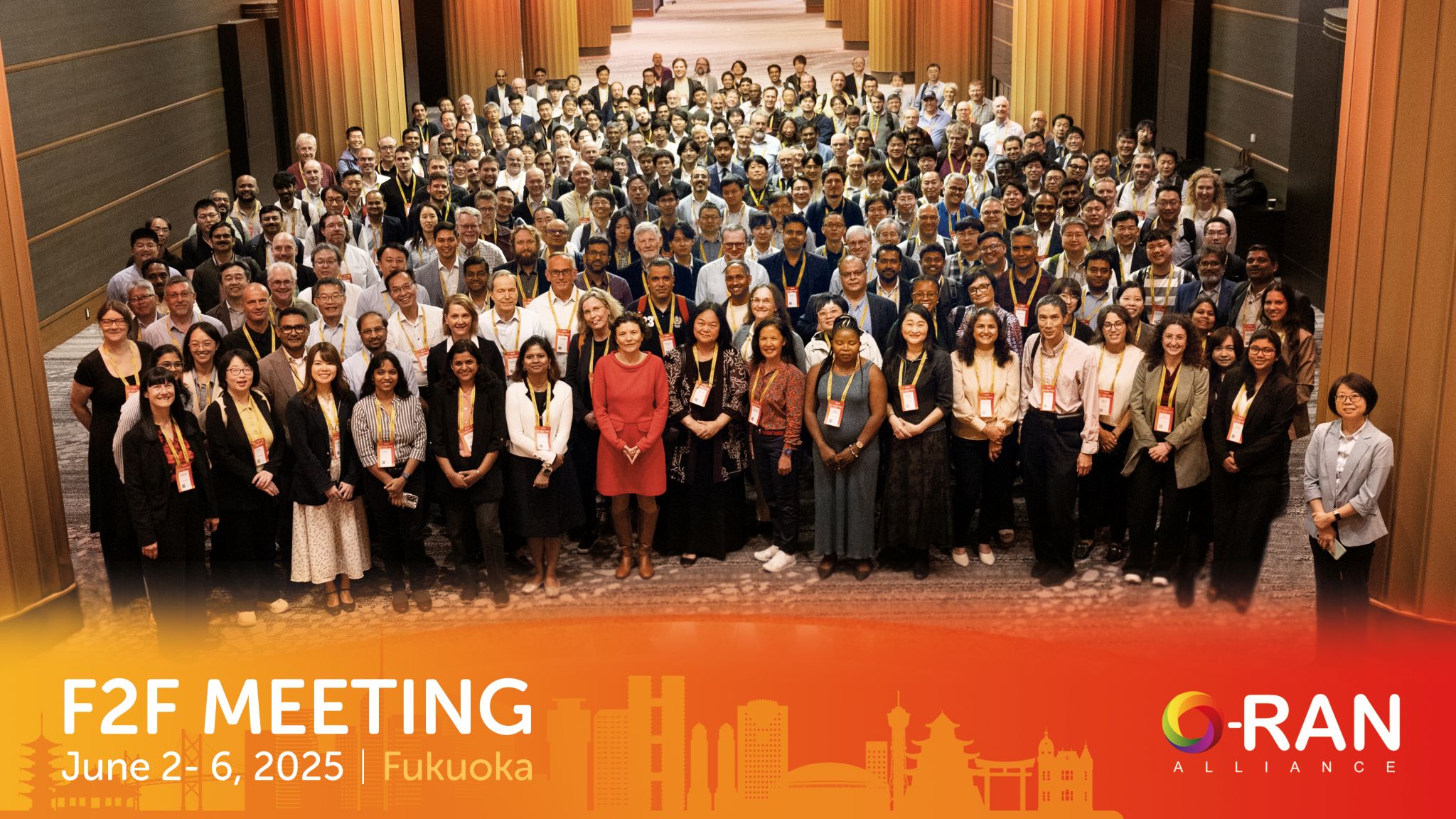
The O-RAN Software Community (SC) is proud to participate in the O-RAN ALLIANCE Face-to-Face (F2F) Meeting this week in Fukuoka, Japan—a vital gathering that brings together stakeholders from across the global Radio Access Network (RAN) ecosystem. This event is a cornerstone of collaboration, offering a unique opportunity for in-person discussions, planning, and alignment between industry experts from around the world.
With 320 experts from 94 companies and institutions joining in person—and many more connecting remotely—this meeting is a vibrant hub of innovation and progress. Participants span a wide range of sectors, including mobile network operators (MNOs), vendors, research institutions, academia, and government agencies, all working toward the common goal of defining and advancing open, intelligent, and disaggregated RAN.
Throughout the week, 11 parallel work streams run from morning to evening, filled with Work Group and Focus Group sessions. These intensive meetings allow the community to align on architecture, specifications, implementation plans, and interoperability—all essential for advancing the O-RAN vision. Despite time zones or travel fatigue, the energy is high, and the focus is clear: building the future of RAN together.
Face-to-face collaboration plays a critical role in accelerating standardization and resolving complex challenges. That’s why the O-RAN ALLIANCE organizes F2F meetings three times per year, rotating between Asia, Europe, and the Americas. These gatherings help deepen community bonds and strengthen cross-organizational efforts.
The O-RAN Software Community is grateful for the continued dedication of all its members and participants who contribute their time, expertise, and vision. Thank you for helping move the needle toward an open and interoperable RAN ecosystem.
Stay tuned for more updates from Fukuoka and follow our journey at o-ran-sc.org and on LinkedIn.
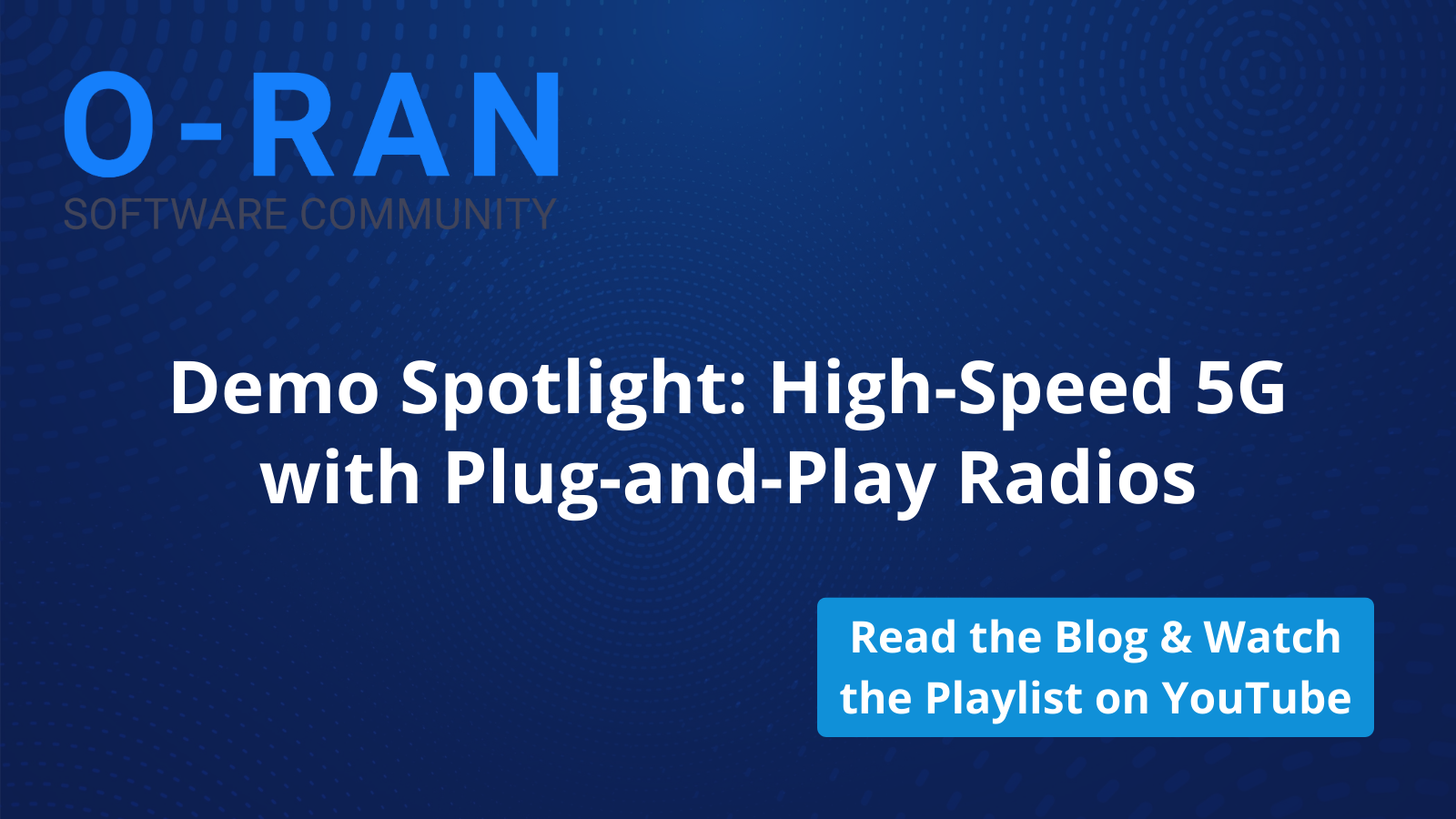
Featuring: Robert Schmidt, OpenAirInterface (OAI)
Event: O-RAN ALLIANCE Meeting, Paris – March 2025
What does the future of 5G really look like? Robert Schmidt from OAI gave us a glimpse—with a live demo that brought together high-speed connectivity, smart automation, and hardware working seamlessly together.
A fully disaggregated 5G base station (gNB) setup achieving ~1 Gbps download speeds. The components were built from open-source software and industry-standard interfaces, using two connected servers and a radio unit (RU). No proprietary software stack, no mystery boxes—just powerful, flexible tech.
Robert showed how:
Think of a city that wants to expand 5G coverage quickly. Instead of sending teams out to configure radios one by one, they can ship pre-configured units that “phone home” and get ready to go in minutes. This demo showed that vision is already possible.
Disaggregated 5G OAI gNB with Benetel O-RUs
Follow us on LinkedIn to get updates like this, plus community news and release announcements:
🔗 linkedin.com/company/o-ran-software-community-sc
Coming Soon: The L Release brings even more performance improvements and integration features. Stay tuned!
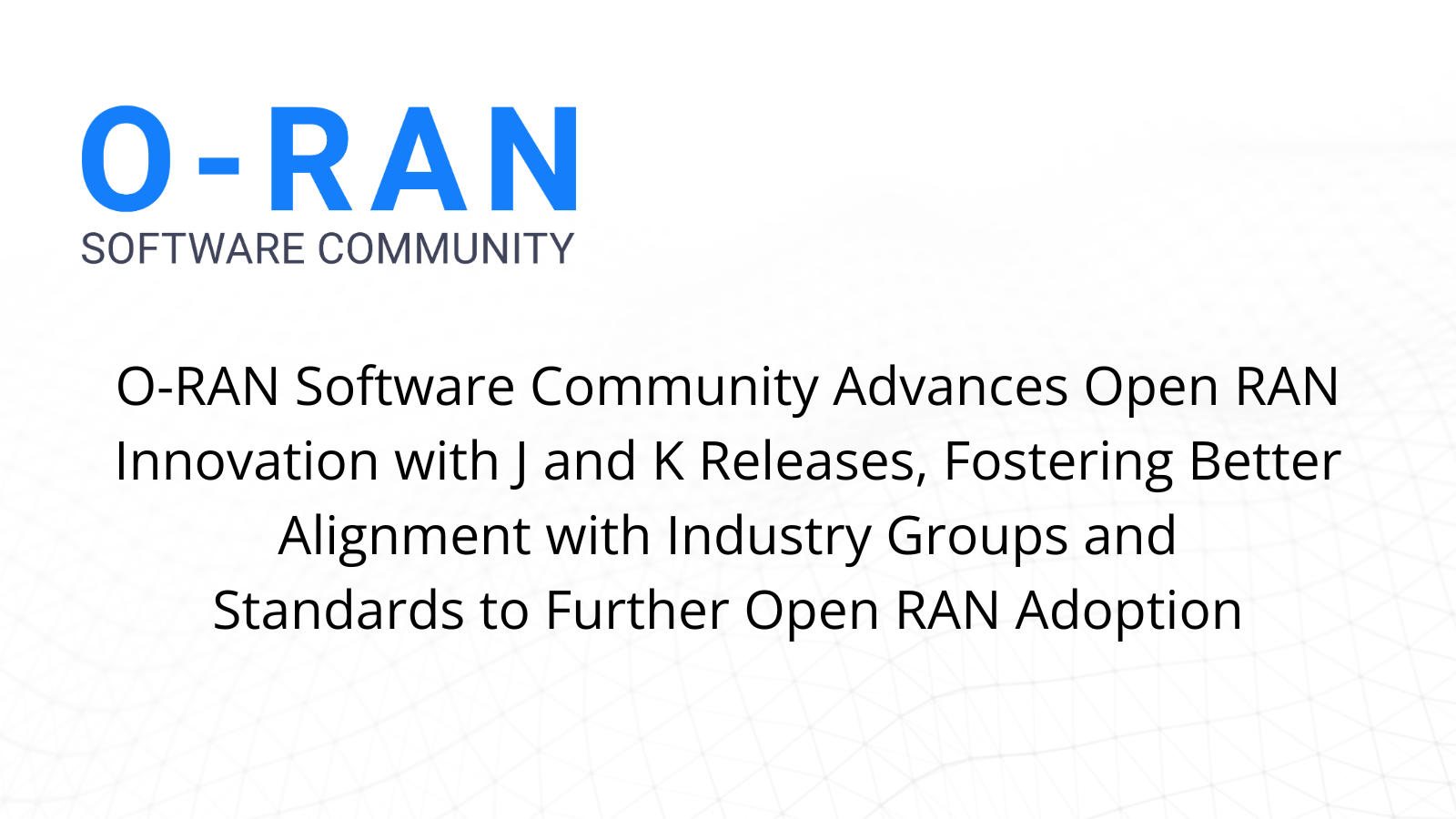
New software releases further enable open Radio Access Network (RAN) adoption aligned to
O-RAN ALLIANCE standards
San Francisco, CA, USA and Bonn, Germany — April 3, 2025 — The O-RAN Software Community (O-RAN SC), sponsored by the O-RAN ALLIANCE (O-RAN) and operated by the Linux Foundation, announced the availability of its J and K software releases strengthening collaboration across the open RAN ecosystem. These releases, based on O-RAN specifications, enhance integration between the O-RAN SC and the OpenAirInterface (OAI), enhance integration with Intel FlexRAN™ reference software, provide a more robust platform for RAN Intelligent Controller (RIC) application developers, and introduce an improved simulator for researchers. These achievements highlight the O-RAN SC’s commitment to advancing open-source innovation in the RAN industry.
The J and K releases demonstrate how the O-RAN SC is meeting industry demands for open, efficient, and modular RAN software solutions. The releases also address critical issues such as interoperability, security, and scalability, paving the way for widespread adoption of open-source technologies across the telecommunications ecosystem.
“Open-source innovation is critical to accelerating the adoption of open and intelligent RAN, and projects like the O-RAN SC are poised to lead the way,” said Arpit Joshipura, general manager, Networking, Edge & IoT at The Linux Foundation. “The work being done in this community is essential in reducing resources required for commercial and product offerings during the transition to next-generation technology. The recent releases represent the next step in that journey.”
“In partnership with the Linux Foundation, O-RAN ALLIANCE established the O-RAN Software Community to provide the RAN industry with efficient open-source software solutions, helping to advance the development of open and intelligent RAN solutions,” said Chih-Lin I, Co-chair of O-RAN ALLIANCE’s Technical Steering Committee and China Mobile Chief Scientist, Wireless Technologies, China Mobile Research Institute. “We support expanding cooperation among software communities to broaden the range of open-source functions for developers and operators deploying them in their networks. A big thank you to all contributors driving the open-source innovation.”
The J and K releases reflect critical advancements in the O-RAN SC’s mission to enable open, intelligent, and interoperable RAN technologies. These releases drive open-source adoption, improving interoperability, integration, and AI/ML support. Notable examples include RIC Testing as a Platform (RIC-TaaP), a collaboration with Orange that advances xApp/rApp design and testing, and an OAM solution for Distributed RAN, showcased at India Mobile Congress 2024, enhancing real-time network management.
“These releases underscore the power of collaboration within the O-RAN SC,” said David Kinsey, Expert Member of Technical Staff, AT&T and Co-Chair for the O-RAN Software Community. “In alignment with the O-RAN ALLIANCE, the O-RAN SC addresses real-world challenges and delivers solutions that advance the adoption of open-source technologies in telecommunications.”
The O-RAN SC will continue to prioritize innovation and collaboration in 2025, focusing on key advancements expected in the upcoming L release. These include the introduction of a new simulator, the development of additional xApps, enhancements to the AI/ML framework, and improved integration between the O-RAN SC O-DU and OAI. The community remains committed to expanding deployment use cases, refining technical documentation, and fostering deeper engagement within the telecommunications and open-source communities.
To learn more about O-RAN SC and the J and K releases, as well as what the community has contributed in earlier releases, visit www.o-ran-sc.org.
The Linux Foundation is the world’s leading home for collaboration on open-source software, hardware, standards, and data. Linux Foundation projects are critical to the world’s infrastructure including Linux, Kubernetes, Node.js, ONAP, OpenChain, OpenSSF, PyTorch, RISC-V, SPDX, Zephyr, and more. The Linux Foundation focuses on leveraging best practices and addressing the needs of contributors, users, and solution providers to create sustainable models for open collaboration. For more information, please visit us at linuxfoundation.org. Linux is a registered trademark of Linus Torvalds.
The O-RAN ALLIANCE is a world-wide community of mobile operators, vendors, and research & academic institutions operating in the Radio Access Network (RAN) industry. As the RAN is an essential part of any mobile network, the O-RAN ALLIANCE’s mission is to re-shape the industry towards more intelligent, open, virtualized and fully interoperable mobile networks. The new O-RAN specifications enable a more competitive and vibrant RAN supplier ecosystem with faster innovation to improve user experience. O-RAN based mobile networks at the same time improve the efficiency of RAN deployments as well as operations by mobile operators. To achieve this, the O-RAN ALLIANCE publishes new RAN specifications, releases open software for the RAN, and supports its members in integration and testing of their implementations.
For more information, please visit www.o-ran.org.
O-RAN ALLIANCE PR Contact:
Zbynek Dalecky
pr@o-ran.org
O-RAN ALLIANCE e.V.
Buschkauler Weg 27
53347 Alfter/Germany
Linux Foundation Media Contact:
Noah Lehman
The Linux Foundation
nlehman@linuxfoundation.org
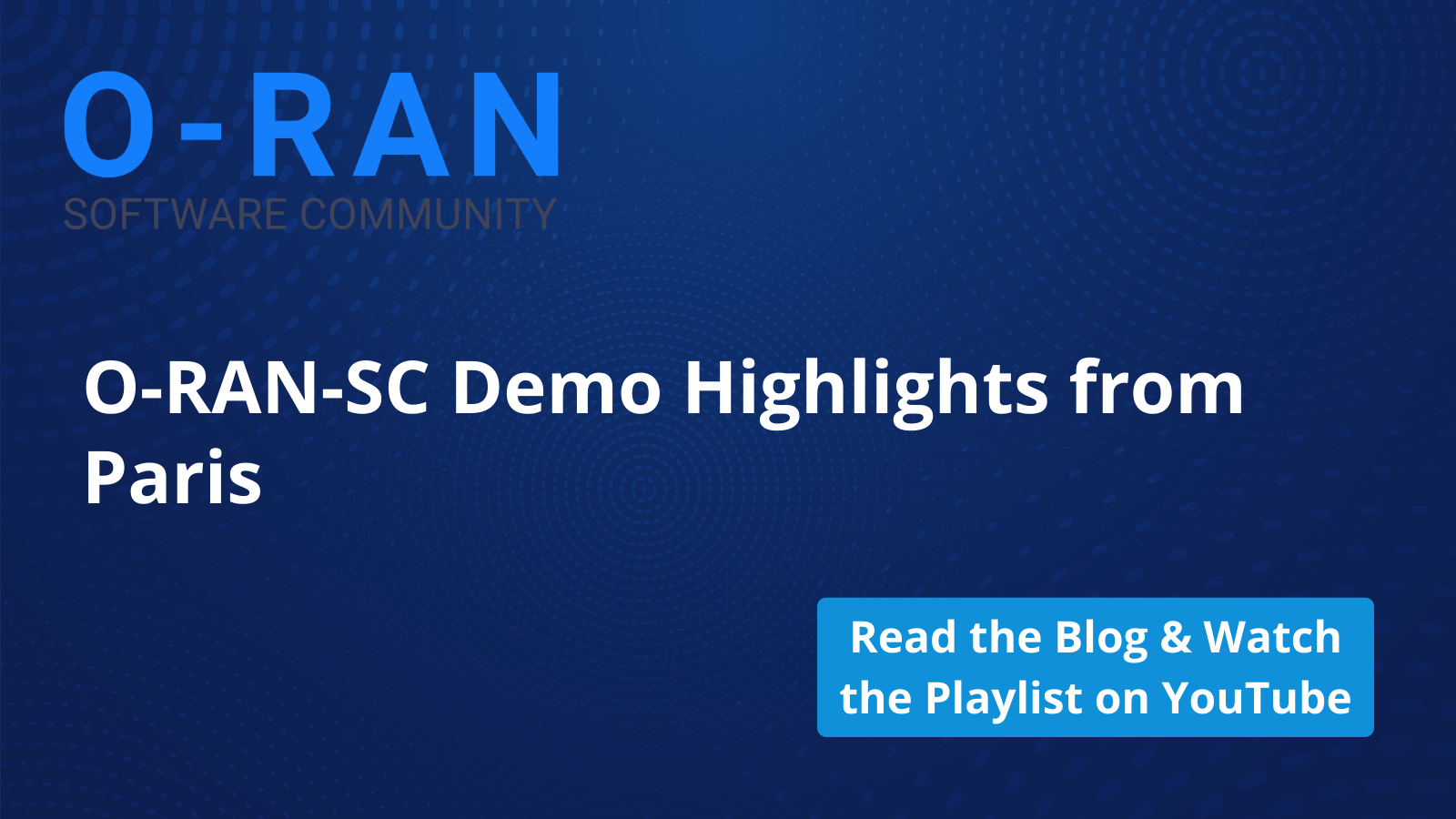
The O-RAN ALLIANCE Face-to-Face Meeting, the first of 2025, took place in Paris. Members of OpenAirInterface Software Alliance (OAI), Nephio, and the O-RAN Software Community (O-RAN-SC), showcased new developments and demos around Service Management and Orchestration (SMO), the Non-RT RIC, Open Fronthaul, and more. Below is a quick walkthrough of the demos, the technology behind them, and why they matter.
Robert Schmidt from the OpenAirInterface (OAI) Software Alliance kicked off by showing a high-throughput, disaggregated 5G OAI gNB setup that uses:
Watch the Video.
Ivan described the new O-RAN-SC Lab co-located with the existing ORBIT and COSMOS testbeds at Rutgers. This environment provides remotely accessible servers, RUs, test equipment, and more for O-RAN-SC developers to run large-scale tests.
Sagar showcased how the Nephio project (under Linux Foundation Networking) can create and manage Kubernetes clusters for O-RAN-SC deployments. By taking an “intent-based” GitOps model, Nephio orchestrates O-Cloud resources and O-RAN workloads.
Watch the Video.
Teodora closed out the session with a look at OAI’s support for O1 management (via NETCONF) and E2 (via FlexRIC, a nearRT-RIC + xApp framework). The goal: demonstrate real-time reconfiguration and performance reporting from a COTS UE, plus monitoring via E2-based xApps.
Watch the Video.
Alex kicked off the demo session with a deep dive into how an O-RU can automatically discover its management-plane (M-Plane) endpoint using DHCP. According to the latest Open Fronthaul M-Plane specs (Release 16.0.1), DHCP can carry far more information than just an IP address—particularly, details about the SMO’s domain name and whether NetConf call-home should happen via SSH or TLS.
In real-world deployments, radios need a fast, standardized way to locate their controlling SMO (or OAM system). By embedding these parameters within DHCP, operators can streamline the “power-on” or “plug-and-play” workflow for large numbers of O-RUs. This demo clarifies how the RU can use DHCP Option 43 to retrieve not just its IP address, but also SMO’s FQDN, NetConf transport type, and even references to event-collector endpoints.
Next up, John Keeney and Jeff demonstrated how SMO can provide a high-level, consolidated view of all the network domains—like RAN, Cloud, OAM systems, and more—via the newly developed Topology Exposure & Inventory Service (TE&IV). They illustrated geographic queries, grouping of network entities (e.g., by location or by type), and dynamic group updates.
Most operators have many data sources—RAN inventory, physical sites, cloud infrastructure details, and so on. O-RAN Alliance Work Group 10 is defining an API so external applications (rApps, for example) can access an abstracted, cross-domain network view rather than piecing everything together themselves. This means your advanced analytics or optimization modules can fetch “just enough” topology info in a single call.
Watch the Video.
Shashikanth gave a broader look at how the O-RAN-SC SMO project is evolving. Specifically, he presented the architecture where federated O-Cloud orchestration (FOCOM) works in tandem with a Network Function Orchestrator (NFO), with supporting modules like an Inventory Management Service (IMS) and a Deployment Management Service (DMS).
Operators often need to unify orchestration across multiple clouds (public, private, or on-prem). The SMO project is exploring new ways to fold in open-source orchestration tools (e.g., StarlingX, Tacker, Open MSA) and handle both VMs and container-based VNFs/CNFs.
Shridhar showcased how the IOS-MCN project in India (backed by the Government of India) is integrating key O-RAN-SC components—especially the OAM, Non-RT RIC, and RAN-PM modules—into their real-world lab. Their setup pairs O-RAN-SC containers with OpenAirInterface (OAI) gNBs and real mobile phones.
It’s a testament to how these open-source modules (OAM, RAN-PM, etc.) can be deployed “as is” into an external system. Having minimal code modifications means that community-driven solutions truly save time for integrators. In the demo, we see OAI gNBs come online, register through NetConf, and send PM (performance) data to Kafka and InfluxDB, where the SMO visualizes throughput, number of UEs, etc.
Alex returned to spotlight a PyNTS-based DU simulator that produces synthetic 5G NR performance data in the 3GPP TS 28.532 (Release 18) XML format. This O-DU simulator periodically sends “file-ready” notifications, which the SMO retrieves using standard NetConf-based triggers (SFTP for the file itself) and then pushes into InfluxDB and Kafka.
While real DUs (or OAI-based setups) are great, they may be harder to come by in early testing, or you may want to scale up 1,000 DUs for performance benchmarking. A simulator that is fully compliant with the same file-based PM approach is invaluable. It confirms the entire chain—NetConf, file retrieval, PM data ingestion, and rApp consumption—runs smoothly before swapping in actual hardware.
Watch the full Video on the O-RAN SC YouTube channel.
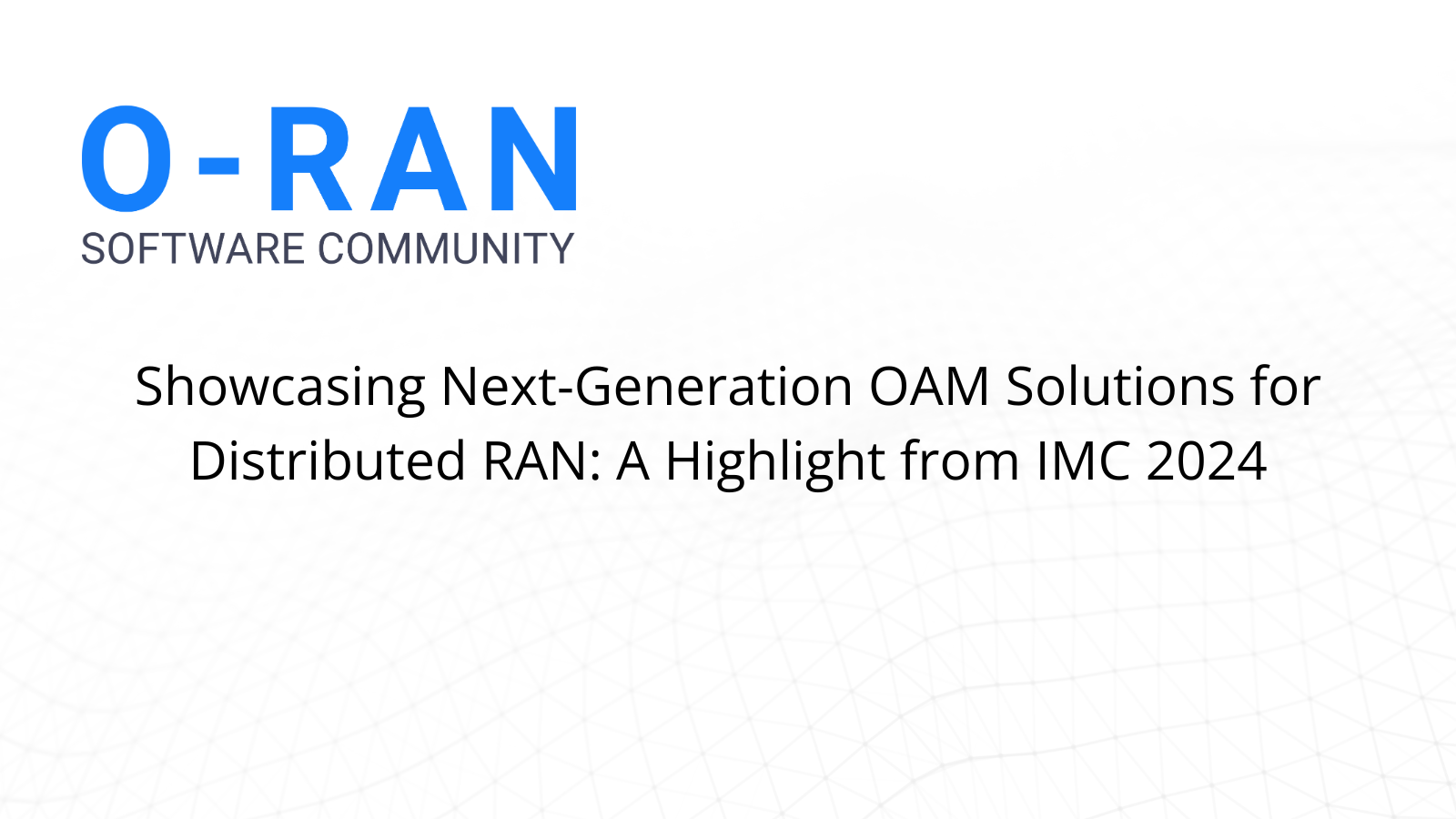
The O-RAN Software Community (SC) continues to push the boundaries in developing open source solutions for the next era of wireless communication. At the India Mobile Congress (IMC) 2024, O-RAN Software Community (SC) along with the India Open Source (IOS) for Mobile Communication Network (MCN) team showcased an innovative Operations, Administration, and Maintenance (OAM) solution designed to support the needs of Distributed RAN (Radio Access Network) systems. As networks grow more complex, reliable and intuitive OAM systems become essential for managing distributed infrastructure effectively and efficiently.
The demonstration was designed to highlight how a scalable and web-based interface could enhance operational insights and streamline maintenance across a distributed network architecture. The demonstration showcased the following core elements:
The next phase of development promises even more advanced capabilities, including enhanced automation for fault management and predictive maintenance powered by AI. This roadmap reflects O-RAN Software Community (SC)’s commitment to staying at the forefront of RAN innovation by prioritizing network resilience and operational efficiency.
Join Us at the O-RAN F2F Meeting in Paris
An extended version of this demo will be presented at the upcoming O-RAN F2F meeting in Paris (February 2025), offering additional insights and enhancements. Don’t miss this opportunity to see the latest advancements in OAM solutions for Distributed RAN. To stay informed on the latest updates, visit our website and follow us on LinkedIn.